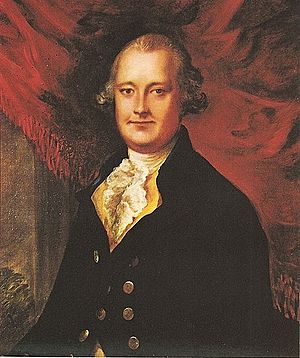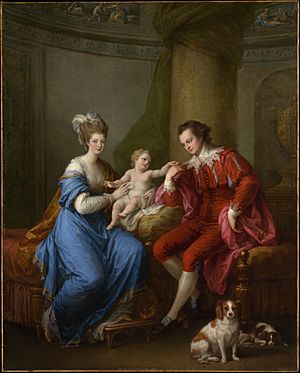Edward Smith-Stanley, 12th Earl of Derby facts for kids
Quick facts for kids
The Earl of Derby
|
|
|---|---|
 |
|
| Chancellor of the Duchy of Lancaster | |
| In office 29 April 1783 – 17 December 1783 |
|
| Monarch | George III |
| Prime Minister | The Duke of Portland |
| Preceded by | The Lord Ashburton |
| Succeeded by | The Earl of Clarendon |
| In office 12 February 1806 – 31 March 1807 |
|
| Monarch | George III |
| Prime Minister | The Lord Grenville |
| Preceded by | The Lord Harrowby |
| Succeeded by | Hon. Spencer Perceval |
| Personal details | |
| Born | 1 September 1752 (O.S.) [12 September 1752 (N.S.)] |
| Died | 21 October 1834 |
| Nationality | British |
| Political party | Whig |
| Spouses | Lady Elizabeth Hamilton (1753–1797) Elizabeth Farren (d. 1829) |
| Children | Edward Smith-Stanley, 13th Earl of Derby Lady Charlotte Hornby Lady Elizabeth Henrietta Cole |
| Parents | James Smith-Stanley, Lord Strange Lucy Smith |
| Alma mater | Trinity College, Cambridge |
Edward Smith-Stanley, 12th Earl of Derby (born September 1, 1752 – died October 21, 1834) was an important British politician. He was known as Lord Stanley from 1771 to 1776. He served in government as the Chancellor of the Duchy of Lancaster twice. This role involved managing land and rights belonging to the British Crown. He was also a member of the Privy Council, a group of advisors to the monarch.
Contents
Early Life and Education
Edward Smith-Stanley was the son of James Smith-Stanley, Lord Strange. His grandfather was Edward Stanley, 11th Earl of Derby. His mother was Lucy Smith. Her family owned Weald Hall in Essex.
Edward went to Eton College in 1764. This is a famous school in England. Later, in 1771, he attended Trinity College, Cambridge, a well-known university.
Political Career and Public Service
In 1774, Edward Smith-Stanley became a Member of Parliament for Lancashire. He held this seat until 1776. That year, he inherited his grandfather's title and became the Earl of Derby. This meant he joined the House of Lords, which is part of the British Parliament.
He served as Chancellor of the Duchy of Lancaster from April to December 1783. This was during a government led by the Duke of Portland. He was also made a member of the Privy Council in the same year.
Lord Derby held the Chancellor role again from 1806 to 1807. This time, he served in a government led by Lord Grenville.
Besides his government roles, Lord Derby was also the Lord Lieutenant of Lancashire. He held this position from 1776 until his death in 1834. A Lord Lieutenant is the monarch's personal representative in a county. He also supported important projects, like the Manchester Bolton & Bury Canal navigation in 1791.
Influence on Horse Racing
Lord Derby had a huge impact on horse racing. In 1778, he hosted a dinner party at his estate, "The Oaks". There, he and his friends planned a new horse race. The next year, Lord Derby's own horse, Bridget, won this race. The race was named The Oaks after his estate.
After Bridget's win, they proposed another race for young male horses (colts). Lord Derby and Sir Charles Bunbury tossed a coin to decide who would name the race. Lord Derby won the toss. The race became known as the Derby Stakes. This race is now one of the most famous horse races in the world.
Sir Charles Bunbury won the first Derby race in 1780. Lord Derby himself won it in 1787 with his horse, Sir Peter Teazle. His racing colors were black with a white cap. His contributions to horse racing were very important.
Interest in Gamefowl
Lord Derby was also very passionate about gamefowl. These are types of chickens bred for their fighting ability. He was known for his systematic approach to breeding these birds. He believed that careful breeding and daily care could lead to better success.
He developed a special family of gamefowl. These birds remained popular for almost 200 years after his death. Lord Derby even built a special arena for gamefowl contests in Preston. He often held large contests with other enthusiasts.
He employed skilled trainers for his birds. After his death, his head trainer received all of Lord Derby's birds and equipment. Lord Derby is thought to be the last high-ranking noble to openly take part in this sport.
Family Life
Lord Derby married Lady Elizabeth Hamilton on June 23, 1774. She was the daughter of James Hamilton, 6th Duke of Hamilton. They had three children together:
- Edward Smith-Stanley, 13th Earl of Derby (born 1775 – died 1851)
- Lady Charlotte Stanley (born 1776 – died 1805)
- Lady Elizabeth Henrietta Stanley (born 1778 – died 1857)
Lady Elizabeth died in 1797. Six weeks later, on May 1, 1797, Lord Derby married the actress Elizabeth Farren. They had one daughter:
- Lady Mary Margaret Stanley (died 1858)
Lord Derby passed away on October 21, 1834, at the age of 82. His son, Edward, from his first marriage, became the next Earl of Derby.
Images for kids
-
Portrait of Elizabeth, Countess of Derby, by George Romney, ca 1776-1778
-
Portrait of Elizabeth Farren, by Thomas Lawrence, 1790





